Blog
stories • happenings • adventures
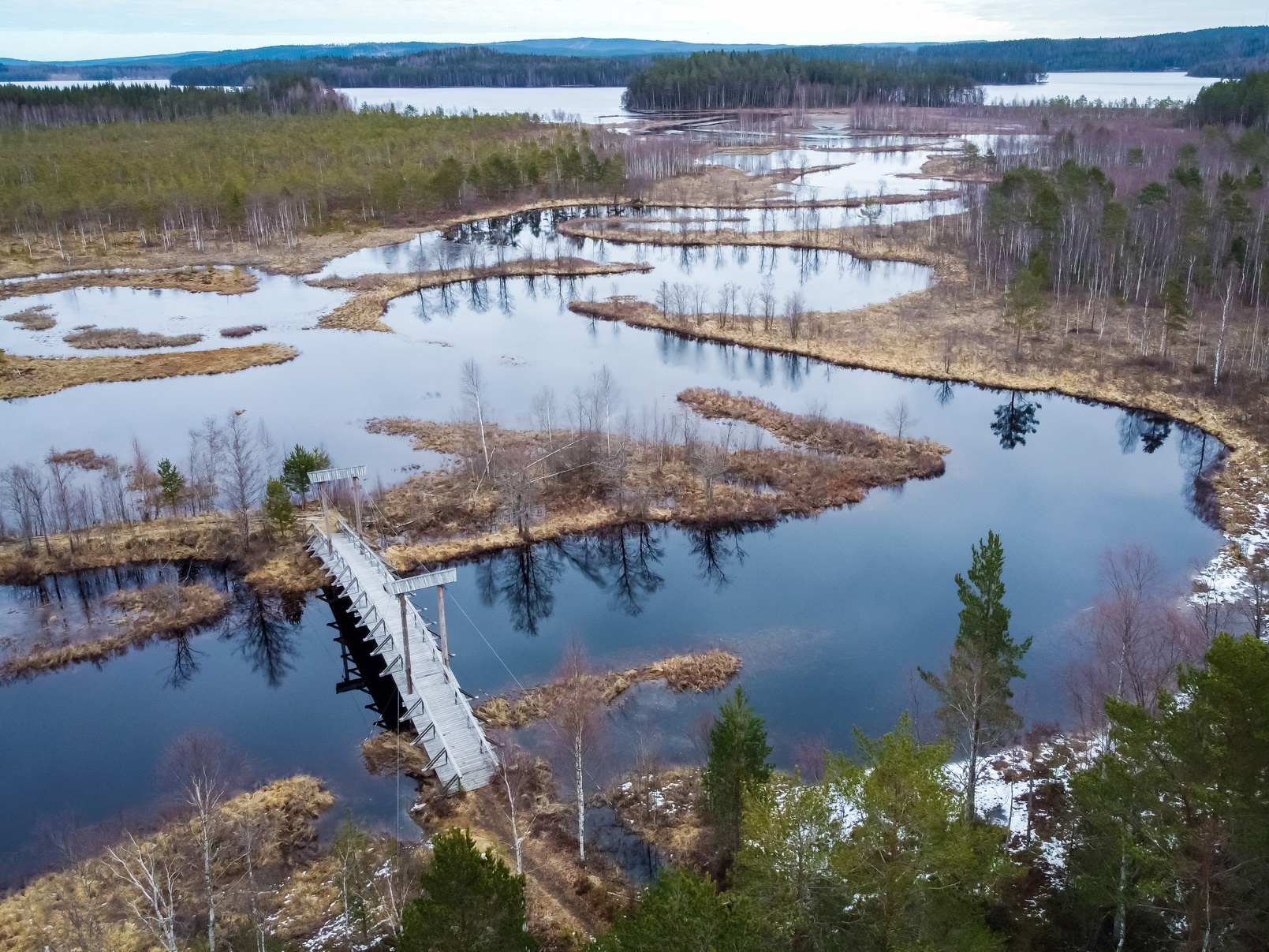
We left Stockholm driving north in our car loaded with adventure gear. Finally my wife and I were going to get some alone time together. It was to be Linnea’s first bikerafting adventure and was slightly nervous at the prospect of spending several days in the remote forest of the Örebro Region in central Sweden. With the sun shining and the temperature a balmy seven degrees celsius, which is not bad for early April in Scandinavia, we waved goodbye to the kids and their grandparents as we drove off. We had planned the tour well, had plenty of food, clothes and all the right equipment to complete our expedition. What could go wrong?
A road closure forced us into the wilderness sooner than we expected. Rough gravel tracks took us towards our starting point. They also took us into darkening clouds and when the first squall hit us the temperatures instantly dropped by ten degrees celsius. Snow was driven horizontally as it plastered the pine forest. We were glad to be still in the car. I could see the worried look in Linnea’s eyes but she was putting on a good show. She knew how important this trip was to me as I wanted us to experience this adventure together to help us re-connect after years of raising a young family.
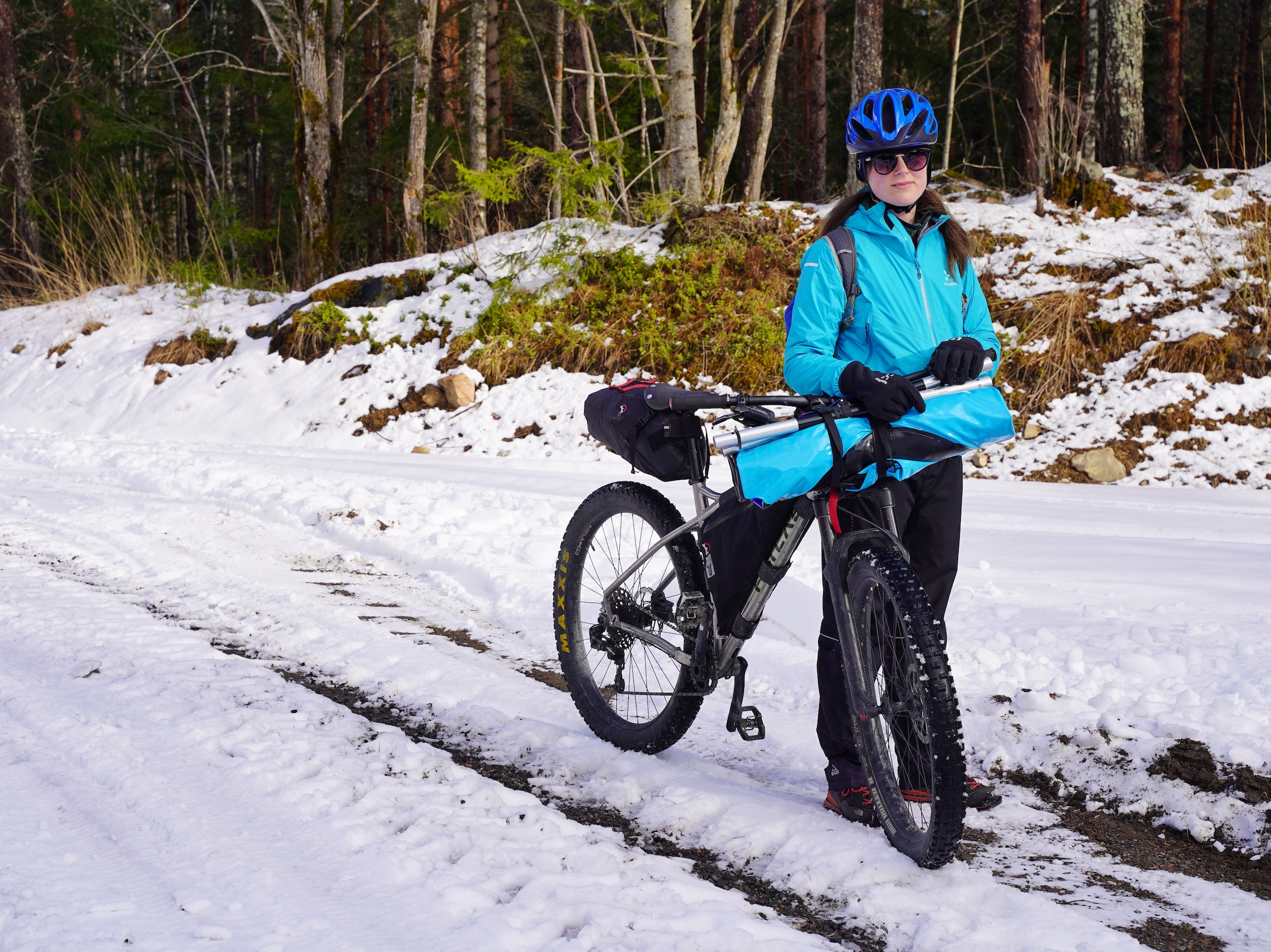 Our plan was to cycle gravel roads up over a pass and down to Uvbergsbron, then inflate our packrafts, load the bikes on them and paddle the Nittälven river to a second bridge where we could take out and bike back to the car. I had chosen this river as it has a remote feeling but isn’t extremely remote. Although only one track crosses the section of river we plan to paddle, and was completely in a forest with no farms or houses nearby, it wasn’t actually ever far from a gravel road. The paddling was to be easy with no more than class one rapids. The perfect beginner’s river for Linnea.
Our plan was to cycle gravel roads up over a pass and down to Uvbergsbron, then inflate our packrafts, load the bikes on them and paddle the Nittälven river to a second bridge where we could take out and bike back to the car. I had chosen this river as it has a remote feeling but isn’t extremely remote. Although only one track crosses the section of river we plan to paddle, and was completely in a forest with no farms or houses nearby, it wasn’t actually ever far from a gravel road. The paddling was to be easy with no more than class one rapids. The perfect beginner’s river for Linnea.
Adding to our safety, the Örebro Region, where we were, had produced a canoeing map of the river, showing all the shelters, rapids and obstacles along the way. But, maps can lie. Well, it’s not that they lie to you or are inaccurate, but they don’t always show the full picture. This was something we were soon to find out.
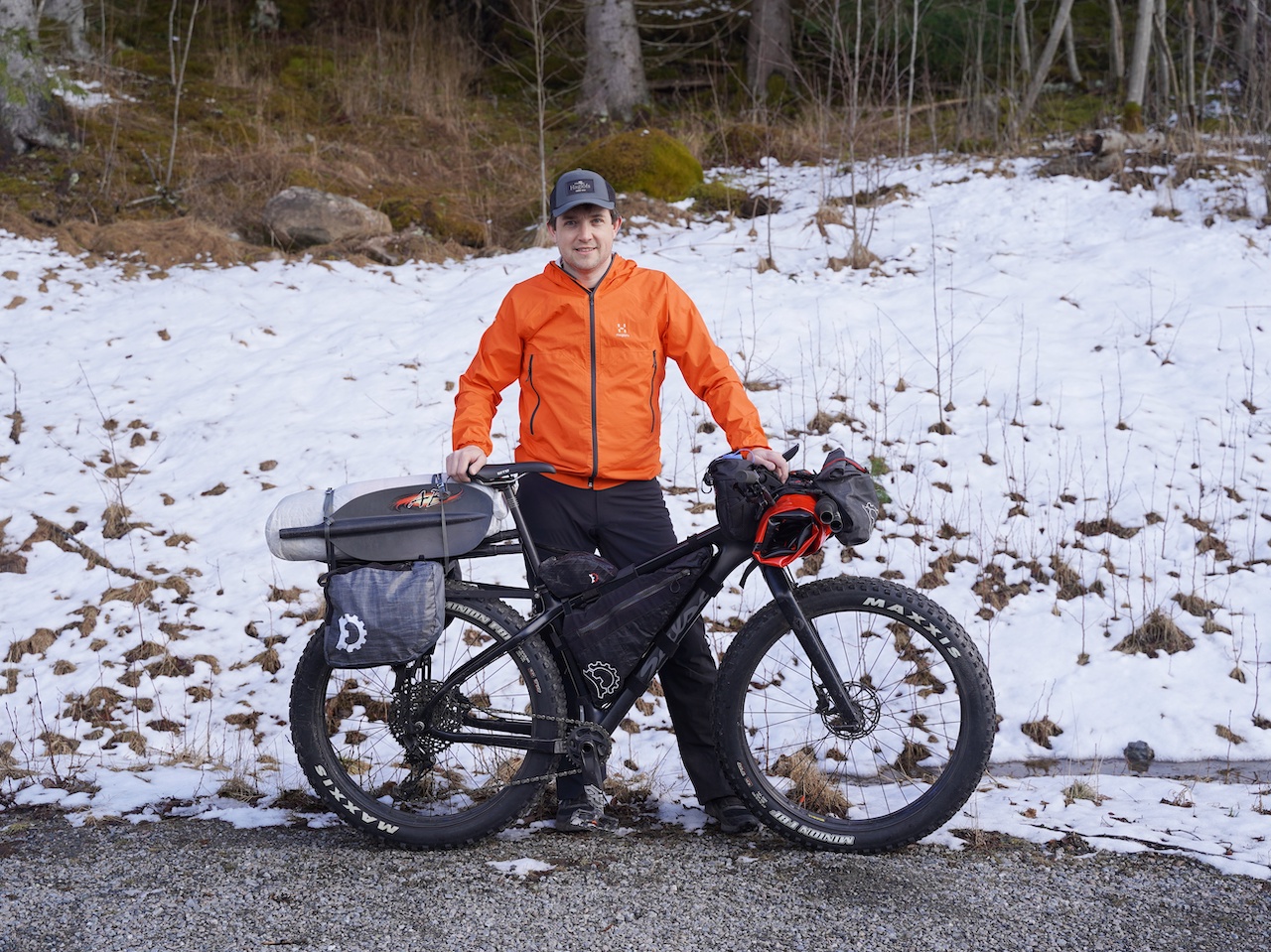 The clouds broke up and the sun appeared as Linnea and I loaded our bikes. In the traditional bikepacking manner we had frame bags, handlebar harnesses and my newly acquired Revelate Designs Nano Pannier bags. Heaviest gear in the middle, packraft on the harness with spare clothes, tent and sleeping equipment in the back. Food was stored in the panniers, two four-piece Aquabound paddles strapped to my OMM bike rack with our two drysuits in a rucksack on my back.
The clouds broke up and the sun appeared as Linnea and I loaded our bikes. In the traditional bikepacking manner we had frame bags, handlebar harnesses and my newly acquired Revelate Designs Nano Pannier bags. Heaviest gear in the middle, packraft on the harness with spare clothes, tent and sleeping equipment in the back. Food was stored in the panniers, two four-piece Aquabound paddles strapped to my OMM bike rack with our two drysuits in a rucksack on my back.
With the afternoon sun on our faces we began our journey. The weather, although a little cold, was glorious. And, with the recently fallen snow the forest looked enchanting. When passing through Genstigsbrännan Nature Reserve I’m pretty certain I saw an ewok. It was that kind of magical.
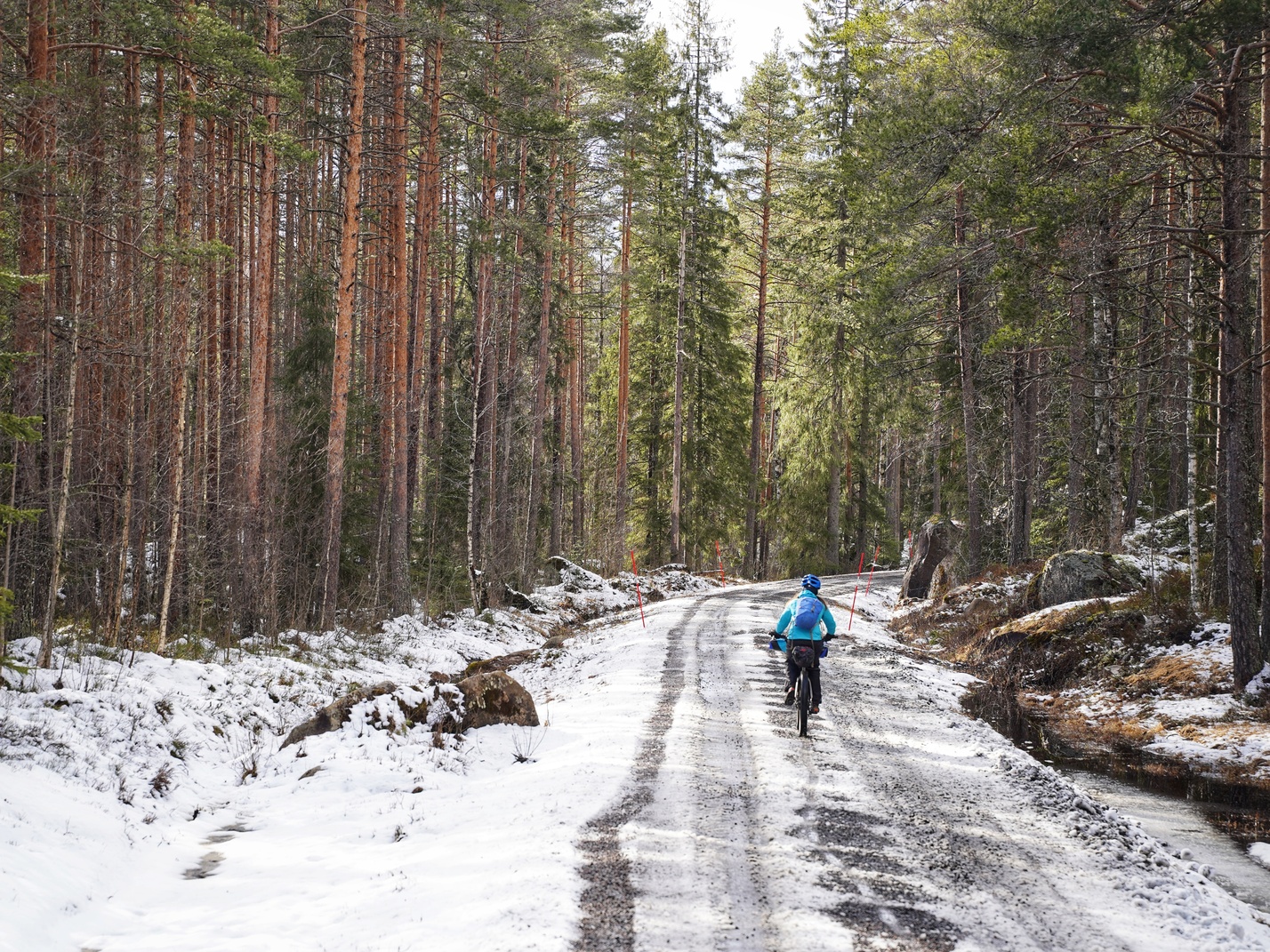 Before long we reached the bridge at Uvbergsbron and stage one of our journey was complete. The day was waning but we both felt it would be a good idea to get on the water that evening. It would give us a feel for what was to come and with a bit of luck we could make it to the newly built hut at Eskils. The forecast was for minus five celsius that night and so an enclosed cabin would be a luxury.
Before long we reached the bridge at Uvbergsbron and stage one of our journey was complete. The day was waning but we both felt it would be a good idea to get on the water that evening. It would give us a feel for what was to come and with a bit of luck we could make it to the newly built hut at Eskils. The forecast was for minus five celsius that night and so an enclosed cabin would be a luxury.
Our bikes were unpacked, gear sorted and reassembled. One of the great things about our modern Alpacka packrafts is that you can access the internal parts of the tubing via an airtight zip. This allowed us to pack all our luggage inside the boat and leave just our bikes and necessary safety equipment on the deck. A clean deck is a safer deck. With fewer items on show there’s less to lose, less unwanted catches and less to distract you when you need to concentrate.
 The river was high with the water flowing fast. The spring melt was doing its job. Linnea shot off downstream with me in quick pursuit. On this fast lumpy section, the rapids spoke to us, their splashes and waves egged us on. We whizzed downstream whooping and shouting as we navigated the waters. My wahoo, still recording and fixed to my handlebars, was showing seven km per hour. This was what we came to do. It was exhilarating, but as the bends in the river got sharper, the water deeper, we slowed down. We drew breath, relaxed and drank it all in. Silence was upon us.
The river was high with the water flowing fast. The spring melt was doing its job. Linnea shot off downstream with me in quick pursuit. On this fast lumpy section, the rapids spoke to us, their splashes and waves egged us on. We whizzed downstream whooping and shouting as we navigated the waters. My wahoo, still recording and fixed to my handlebars, was showing seven km per hour. This was what we came to do. It was exhilarating, but as the bends in the river got sharper, the water deeper, we slowed down. We drew breath, relaxed and drank it all in. Silence was upon us.
The light was fading as the old vindskydd (three-sided shelter) of Eskils Koja appeared through the trees. We could have stopped here but we took a gamble and went searching for the five stars of the newly built hut. It never appeared. With the light fading we made do in a small meadow between the river banks and the thick forest and set up camp.
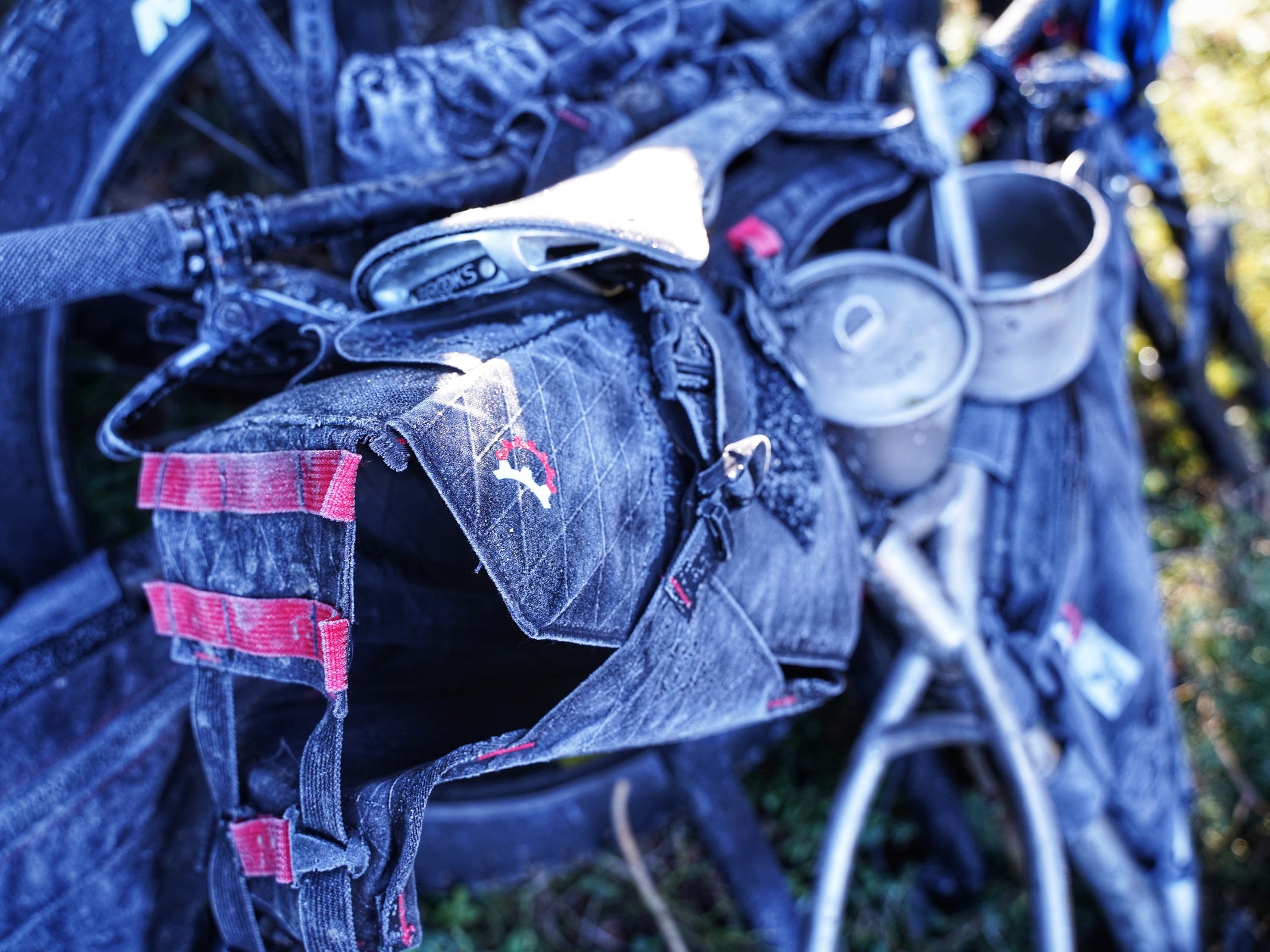 We woke early the following morning with the sunlight splitting through the trees revealing how cold it had gotten the night before. A thick layer of frost covered our bikes and drysuits. All the puddles of water in our boats and equipment were now frozen solid.
We woke early the following morning with the sunlight splitting through the trees revealing how cold it had gotten the night before. A thick layer of frost covered our bikes and drysuits. All the puddles of water in our boats and equipment were now frozen solid.
We had our plan made out for the day. Twenty kilometers needed to be paddled to get to the take out point at a wooden suspension bridge. Judging by the speeds we had been achieving the evening before I was more worried about arriving too early as opposed to not making it.
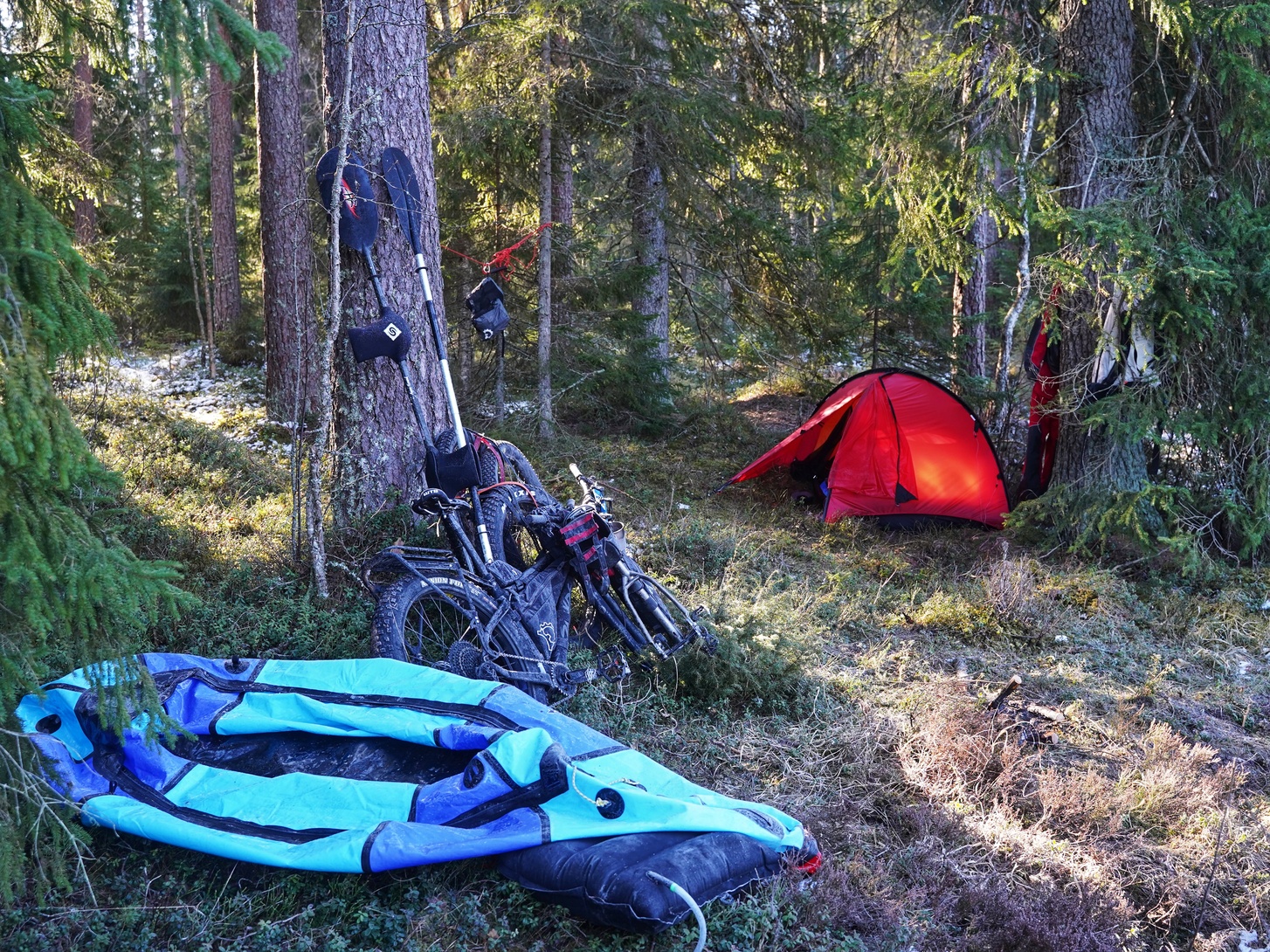 We rejoined the Nittälven and she led us down her well worn path showing us the secrets of the forest. We surprised many beavers who scurried off to their lodges. We were surprised by many birds and ducks whose flapping wings smacked the surface of the water. There were also games of who blinks first with nesting geese on the river banks as we floated past. They always won. I’m not sure if they can blink. They never showed us anyway.
We rejoined the Nittälven and she led us down her well worn path showing us the secrets of the forest. We surprised many beavers who scurried off to their lodges. We were surprised by many birds and ducks whose flapping wings smacked the surface of the water. There were also games of who blinks first with nesting geese on the river banks as we floated past. They always won. I’m not sure if they can blink. They never showed us anyway.
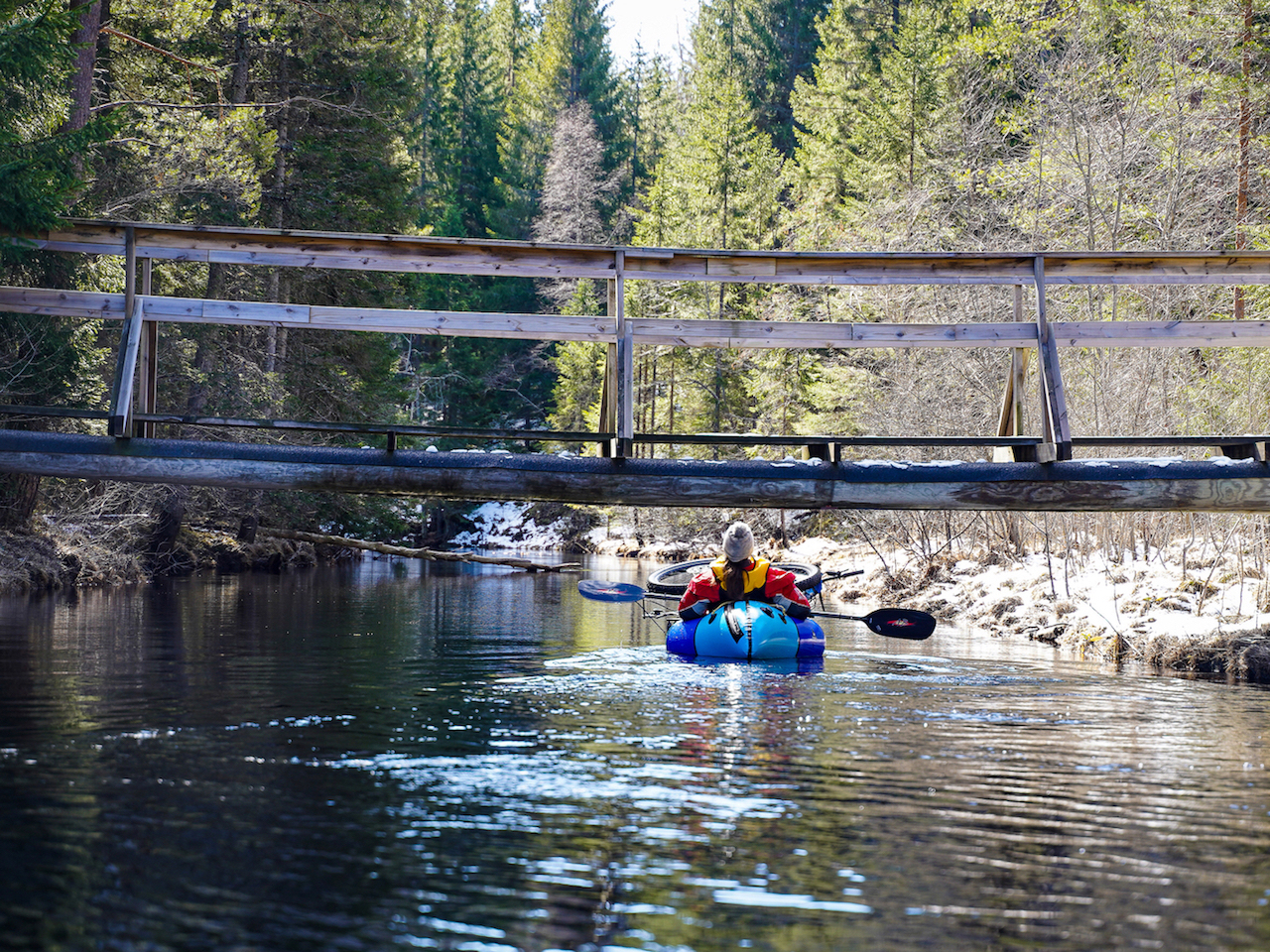 The sun kissed our cheeks as much as the cold air rosied them. The newly installed rock beds as part of the river restoration project threw up some surprises. They weren’t difficult to navigate but did mean we needed to climb out of our boats in sections and guide them through the labyrinth of rocks. I wondered how it would be to travel these parts in lower water levels?
The sun kissed our cheeks as much as the cold air rosied them. The newly installed rock beds as part of the river restoration project threw up some surprises. They weren’t difficult to navigate but did mean we needed to climb out of our boats in sections and guide them through the labyrinth of rocks. I wondered how it would be to travel these parts in lower water levels?
As the afternoon arrived the mood of the river changed. It felt like she had gotten bored and began to toy with us. Instead of allowing us to pass quickly she slowed down and changed direction time and time again. With so many turns our internal compasses got muddled up. It was as if the river had its own magnetic north but wouldn’t let us know in which direction we were to search for it. All we could do was to just follow her flow.
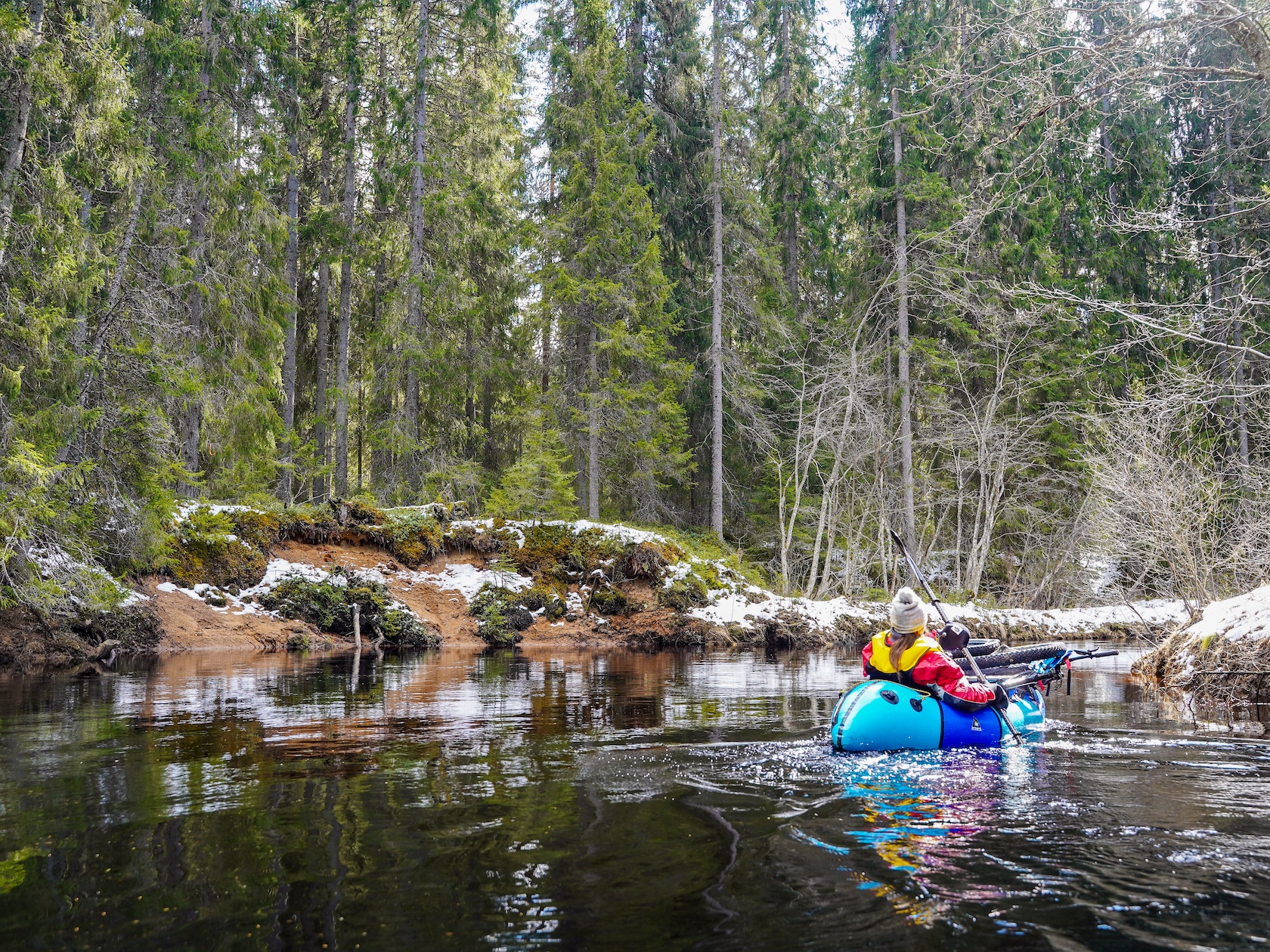 With these games came our problems. The sandy earth of the Nittälven basin was being eaten away by the river as she searched for the fastest way south. With the soil being removed so too were the supports for the evergreen trees flanking her banks. These trees grew tall. Tall enough that when they fell they would span across the width of the river and right across our path. The river didn’t care, she just flowed through each of the sieving branches. The trees would only remain across the river for a few years before being naturally forced downstream during the spring floods. But for now, these trees were our problem.
With these games came our problems. The sandy earth of the Nittälven basin was being eaten away by the river as she searched for the fastest way south. With the soil being removed so too were the supports for the evergreen trees flanking her banks. These trees grew tall. Tall enough that when they fell they would span across the width of the river and right across our path. The river didn’t care, she just flowed through each of the sieving branches. The trees would only remain across the river for a few years before being naturally forced downstream during the spring floods. But for now, these trees were our problem.
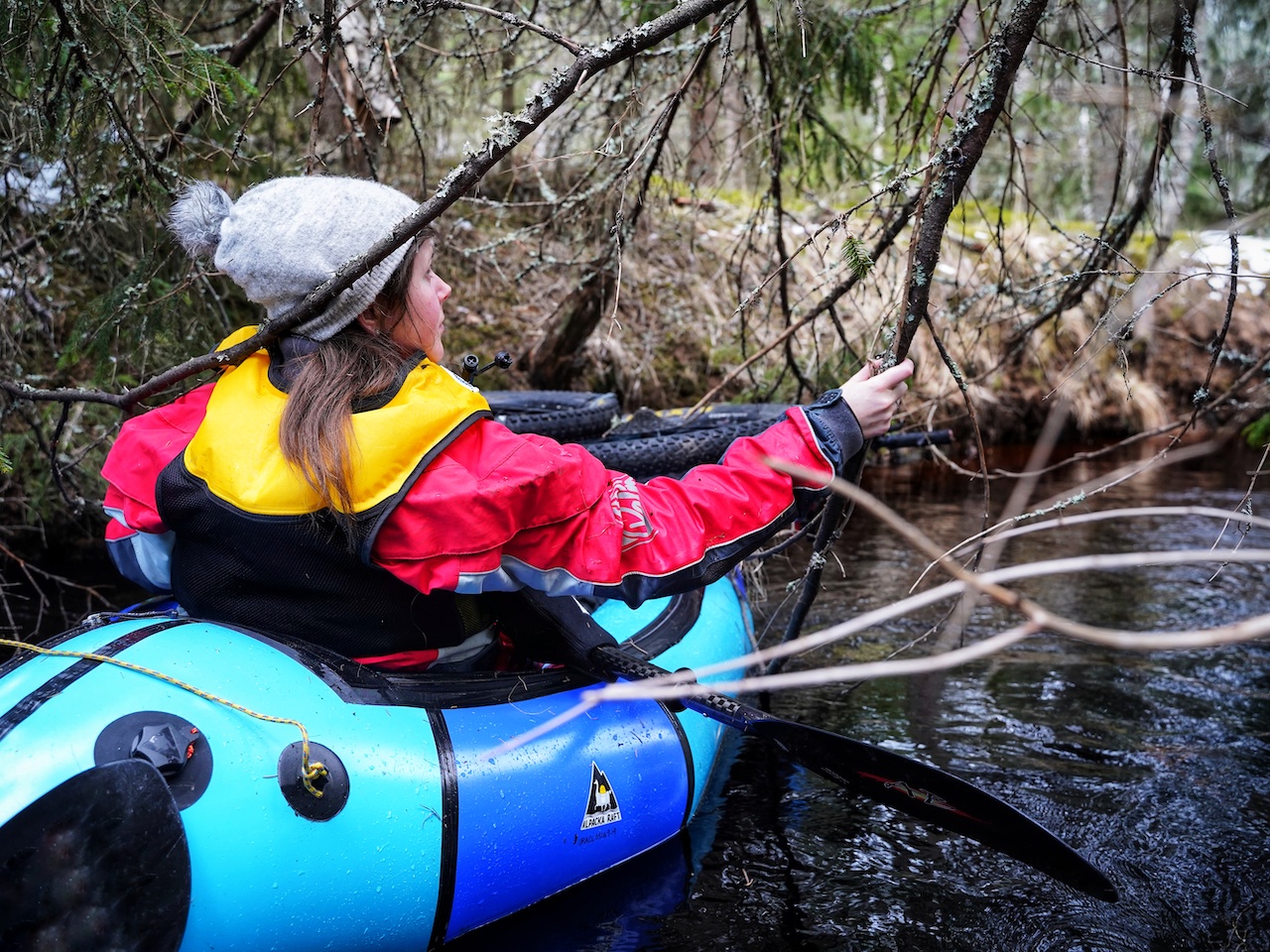 Portage after portage slowed us. In a race against the clock we were losing. Twenty kilometers began feeling like a very long day. As the banks of the river got steeper the portages got harder. I used a kayaking tow rope to help haul the boats up the sides before using it again to lower down back onto the river after the fallen tree had been passed. Where we could, we fought our way through the branches, climbed over the trunk of the trees or did the limbo to save our energy. Anything to make progress.
Portage after portage slowed us. In a race against the clock we were losing. Twenty kilometers began feeling like a very long day. As the banks of the river got steeper the portages got harder. I used a kayaking tow rope to help haul the boats up the sides before using it again to lower down back onto the river after the fallen tree had been passed. Where we could, we fought our way through the branches, climbed over the trunk of the trees or did the limbo to save our energy. Anything to make progress.
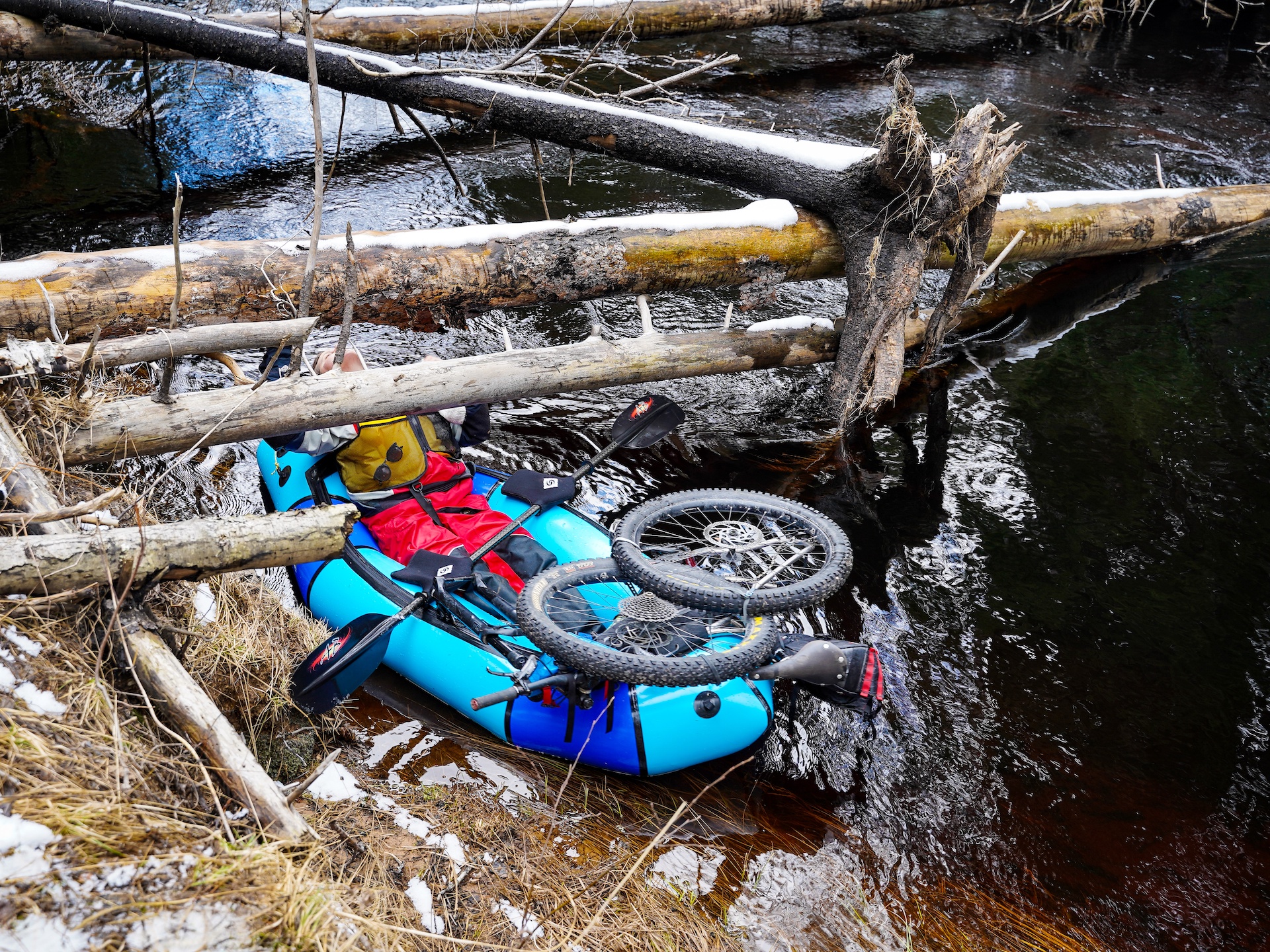 Finally after hours of slow progress we cleared the last of the trees and made our way out to the flooded plains. Exhausted after the day’s adventure we were relieved to reach the wooden suspension bridge as it marked our take out point and there was a shelter located nearby. Pulling into the shallow bay we quickly began unloading our equipment as the day’s light was all but gone and the temperature was beginning to fall.
Finally after hours of slow progress we cleared the last of the trees and made our way out to the flooded plains. Exhausted after the day’s adventure we were relieved to reach the wooden suspension bridge as it marked our take out point and there was a shelter located nearby. Pulling into the shallow bay we quickly began unloading our equipment as the day’s light was all but gone and the temperature was beginning to fall.
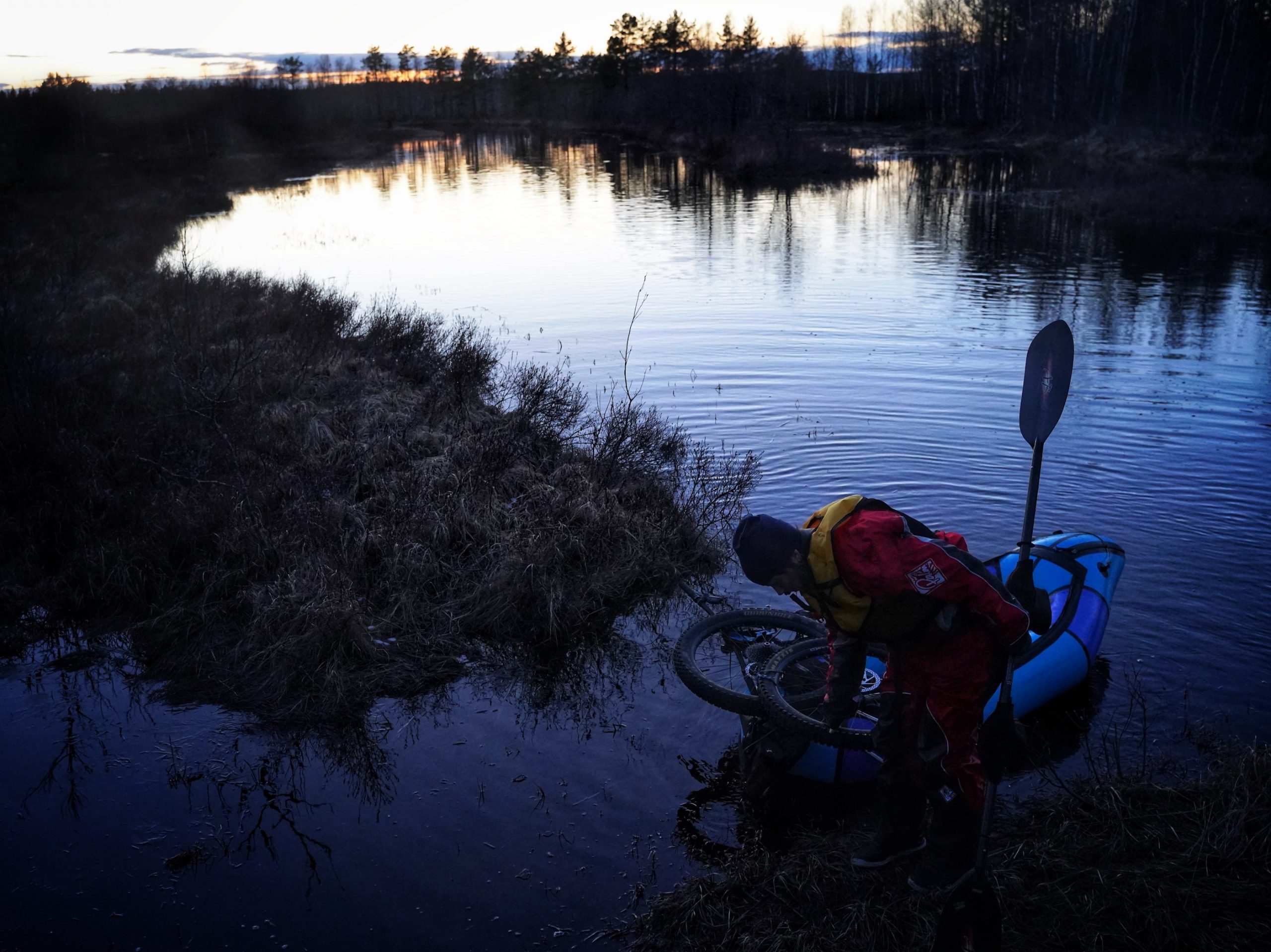 Although I had kept the water out all day with my drysuit, sweat had built up under and had made all my merino wool clothing heavy and damp. Surrounded with the cold air and wearing wet clothes I began to shiver uncontrollably. With this, panic set in. Our equipment was only half unloaded and the bay in which we landed had begun to freeze over, I knew I had to act fast. “Keep calm”, I kept telling myself as I quickly set to work to avoid the on coming dangers. Get the boats out of the water, start a fire and get out of my wet clothes. Although exhausted and violently shivering, I kept moving. I worked as fast as I could and got my blood flowing and body temperature up. By the time the fire was lit I had already stopped shivering and had gained control of the situation.
Although I had kept the water out all day with my drysuit, sweat had built up under and had made all my merino wool clothing heavy and damp. Surrounded with the cold air and wearing wet clothes I began to shiver uncontrollably. With this, panic set in. Our equipment was only half unloaded and the bay in which we landed had begun to freeze over, I knew I had to act fast. “Keep calm”, I kept telling myself as I quickly set to work to avoid the on coming dangers. Get the boats out of the water, start a fire and get out of my wet clothes. Although exhausted and violently shivering, I kept moving. I worked as fast as I could and got my blood flowing and body temperature up. By the time the fire was lit I had already stopped shivering and had gained control of the situation.
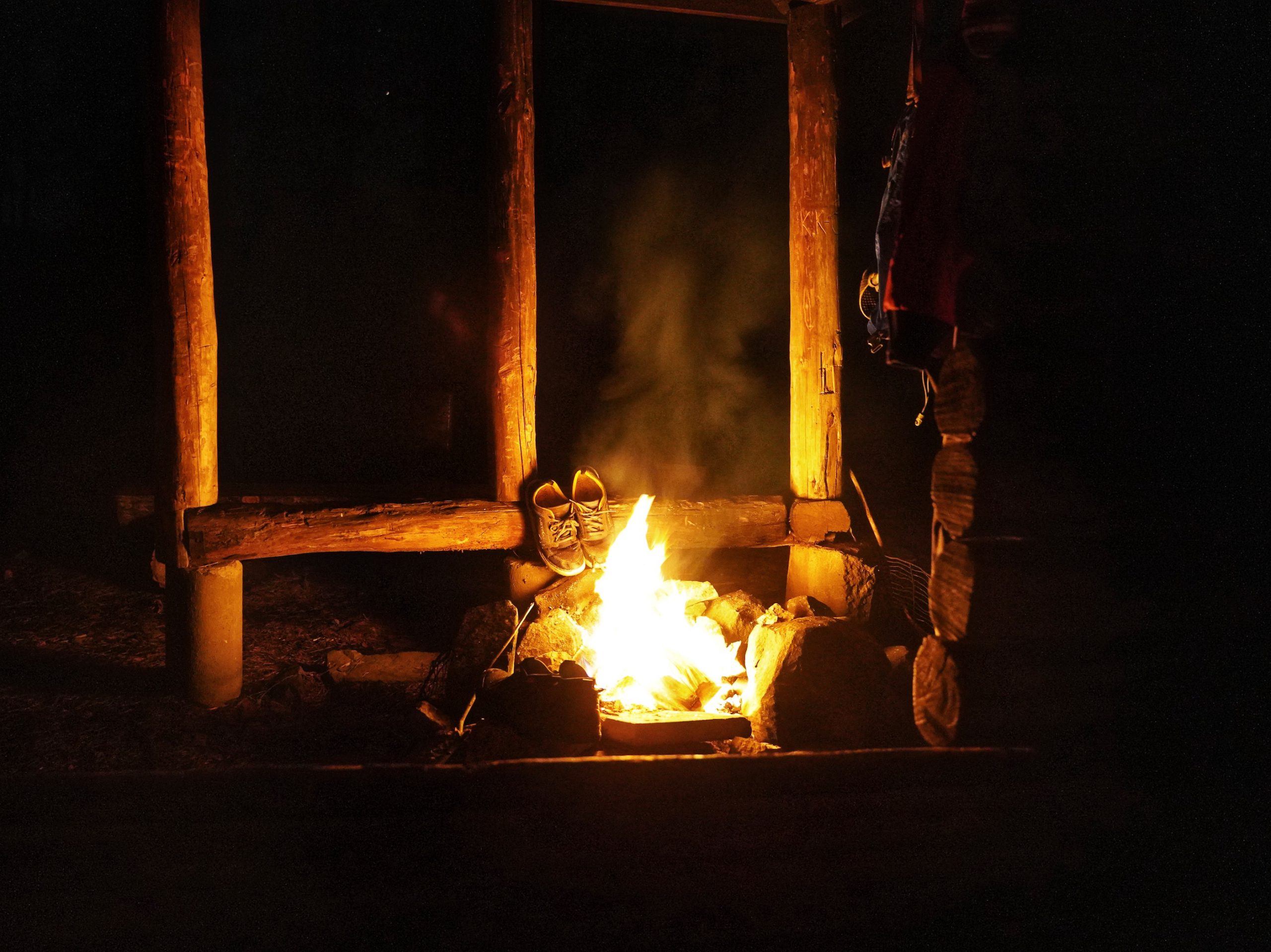 As romantic as it could be, Linnea and I got to sit by the blazing fire that night and watch the stars trek across the sky. Over dinner we discussed the day’s events and how we handled it all. Our easy adventure became a hell of a lot more challenging than even I could have expected.
As romantic as it could be, Linnea and I got to sit by the blazing fire that night and watch the stars trek across the sky. Over dinner we discussed the day’s events and how we handled it all. Our easy adventure became a hell of a lot more challenging than even I could have expected.
We had to work together to get over each of the obstacles we encountered. Giving up was just never an option. We didn’t have a choice. This experience, somewhere between type 1 and type 2 fun, would make us stronger as a couple going forward. If we could navigate the Nittälven we could navigate whatever normal life would throw at us. But for that evening, we didn’t think about the future, we were just happy to be in the moment and enjoying each other’s company.
 With the new day brought the next part of the adventure. We transformed back into cyclists, assembling our bikes, got all our equipment loaded on and headed off. Crossing the suspension bridge marked the end of our river section and the final kilometers of our journey. Our trail began not much wider than our handlebars but gradually expanded as we rolled ever closer to civilization. All too soon it was over. We share a hug to symbolize our victory before heading back to Stockholm to our eagerly waiting kids and whatever obstacles life had in store for us.
With the new day brought the next part of the adventure. We transformed back into cyclists, assembling our bikes, got all our equipment loaded on and headed off. Crossing the suspension bridge marked the end of our river section and the final kilometers of our journey. Our trail began not much wider than our handlebars but gradually expanded as we rolled ever closer to civilization. All too soon it was over. We share a hug to symbolize our victory before heading back to Stockholm to our eagerly waiting kids and whatever obstacles life had in store for us.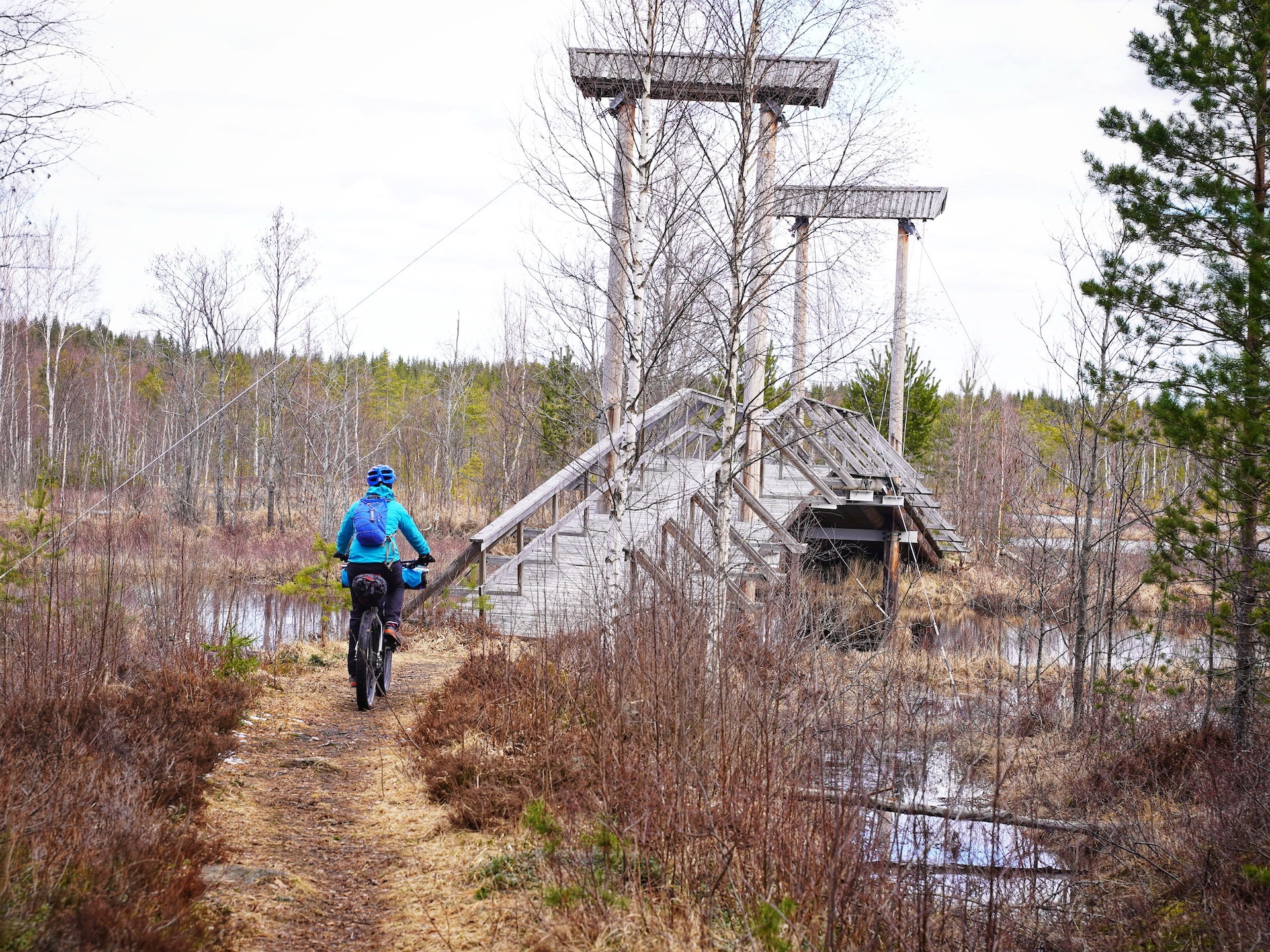
The story doesn’t end here! Head over to Old Man Mountain to read Michael’s full gear breakdown for the trip. Then hop over to Aqua Bound’s site to learn about the history of the Nittälven and the restoration projects taking place to return the river to what it once was.
A native of Ireland, Michael now calls Sweden home. When he’s not running his jewelery company or being a husband and raising four kids, he spends his time exploring. Never content to sit still if he’s not on an adventure he’s designing the next one. Not that it always goes according to plan but if there’s no hike-a-bike involved then it’s not really bikepacking, right? Michael’s obsession is photography and as a keen amateur he loves to document his bikepacking travels. Mongolia, Georgia and Oman to name a few, but he’s equally happy on a local tour.

